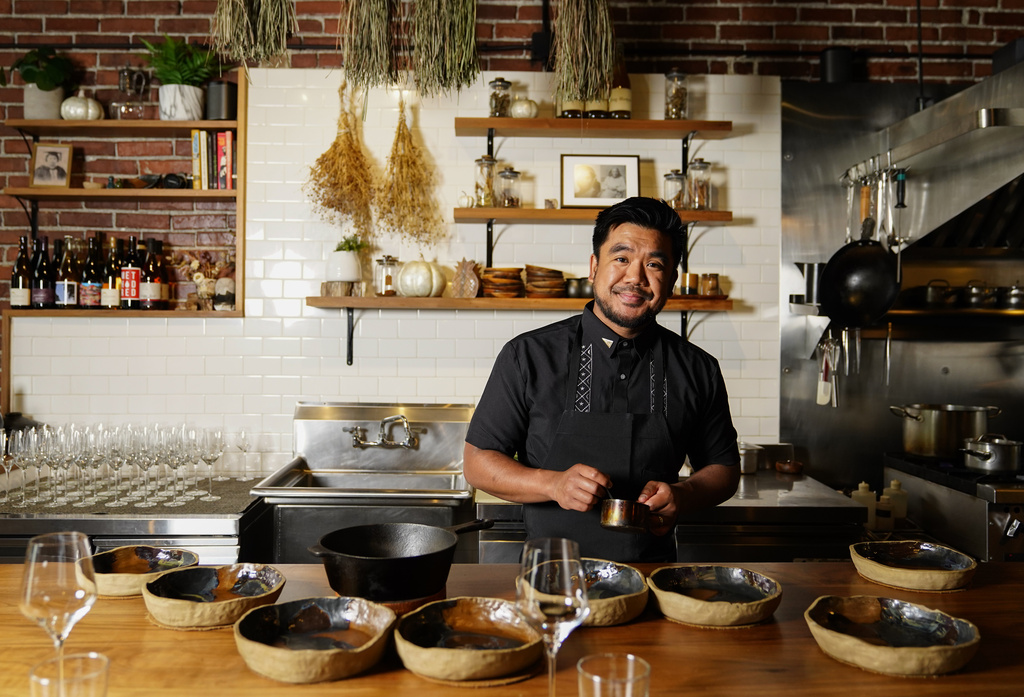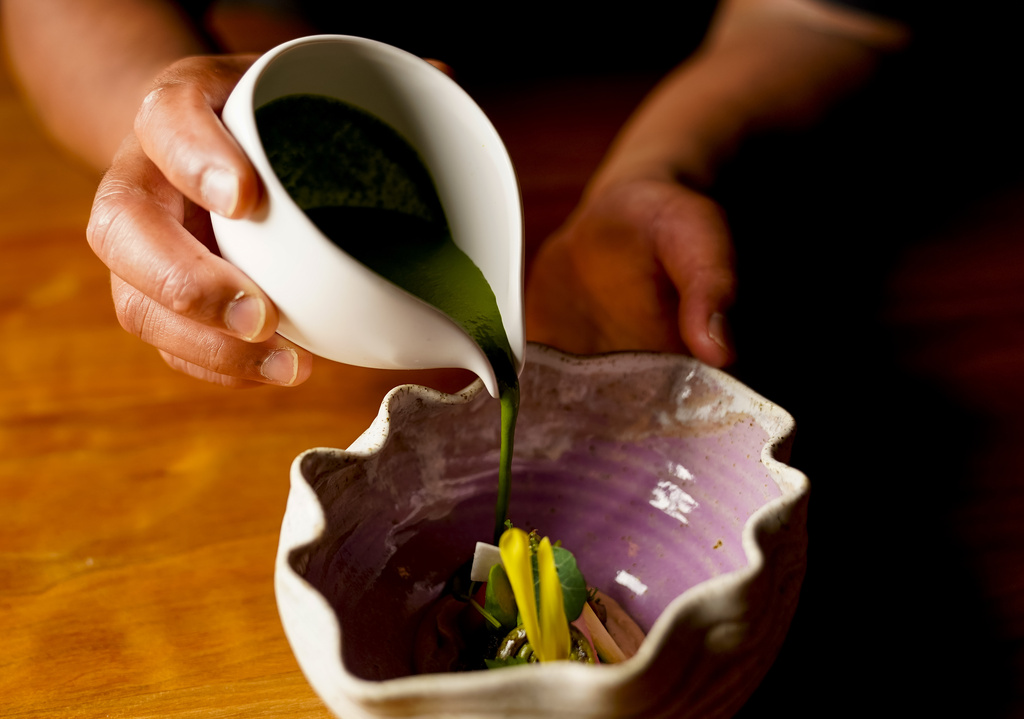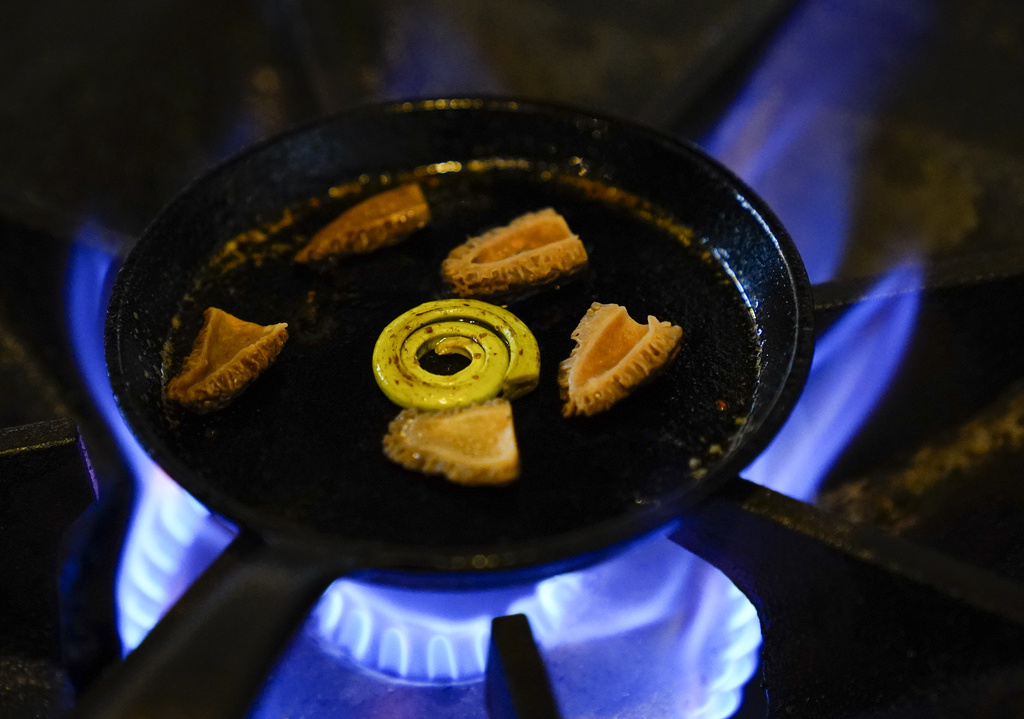アーロン・ヴェルゾーサ氏はこの3年間、多くのシェフがそうであったように、シアトルで自身の経営するフィリピンレストラン「アーキペラゴ」がパンデミックの被害を乗り越えられるよう、懸命に働いてきた。ジェームズ・ビアード賞にノミネートされたのは、その実力がついに認められた瞬間だった。
最優秀シェフ賞(北西・太平洋地域)にノミネートを果たしたヴェルゾーサ氏は、「フィリピン系アメリカ人の文化や北西部のコミュニティについて、そして何よりも両親が歩んできた移民の物語といったストーリーを詳しく紹介することができました……捧げてきたものを見てもらえて、このように地域の代表に選んでいただき、大変恐縮です」と話している。

2023年ジェームズ・ビアード賞にノミネートされてたシェフ、アーロン・ヴェルゾサ氏 AP Photo / Lindsey Wasson
ジェームズ・ビアード賞は、料理界のオスカーに匹敵する。6月5日にはシカゴで、ジェームズ・ビアード財団が毎年開催する授賞式が執り行われ、3つのフィリピンレストランから代表者が出席した。
サンフランシスコの「アバカ」からは、ヴィンス・ブグトン氏が優秀パティシエ・ベイカー賞にノミネート。シカゴの「カサマ」は、ティム・フローレス氏とジニー・クォン氏の夫婦が2人で最優秀シェフ賞(五大湖地域)にノミネートした。同店は昨年、最優秀ニューレストラン賞にノミネートされ、フィリピンレストランとして初のミシュラン掲載店にも選ばれた。フィリピン系アメリカ人としては、これまでにトム・クナーナン氏らがジェームズ・ビアード賞を受賞している。同氏は2019年、現在は閉店してしまったが、「バッド・セイント」というワシントンDCのレストラン在籍時に最優秀シェフ賞(中部大西洋岸地域)を獲得した。
植民地として支配され、真価を認められず抑圧されてきた歴史を持つ料理にとって、こういった賞が与えられるのはどれも喜ばしい評価である。ノミネートしたシェフらは、フィリピン系アメリカ人の体験を料理という言語で表現しようとしている若い世代の一員だ。

サンフランシスコのアバカ・レストラン ペストリーシェフのビンス・ブグトンさん AP Photo / Jeff Chiu
ブグトン氏は、1月にアバカで働き始めるまで、オークランドのカクテルバーでパティシエとしてのアイデンティティ・クライシスに陥っていたという。フィリピンを中心にしたデザートを作りたいと思いながら、「らしさ」が足りないと悩んでいた。しかしアバカでは、シェフでオーナーのフランシス・アン氏が、自身の料理のルーツを自由に追求させてくれた。それからは、タガログ語でカカニンという米をベースにしたデザートなど、スペイン占領以前の時代のフィリピンに由来する料理の試作を重ねている。
「ここで働いたのはわずかな期間ですが、間違いなくとても多くのことを学びました」と、同氏は言う。
ブグトン氏は、フィリピンの食材を用いて試作に興じている。例えば、同国産のバラココーヒーでグラニタを作り、それにマスコバド糖のジュレとレチェ・フランのアイスクリームを合わせてみたいと考えている。レチェ・フランとは、フィリピン版のカスタードプリンだ。
- サンフランシスコのアバカ・レストラン ペストリーシェフのヴィンス・バグトンさんが作るクレームブリュレタルト AP Photo / Jeff Chiu
- レモンシナモンカスタード、ストロベリーグアバジャム、マカダミアココナッツシュトロイゼル、紫芋の泡であるウベエスプーマで作られたクレームブリュレタルト AP Photo / Jeff Chiu
型破りであろうが、フィリピン文化のお決まりの伝統から外れようが、気にしない。
「アイデアが浮かんだときにまず考えるのは、『それが好きかどうか』です。フィリピン系アメリカ人としての自分を表現できるだろうかと。そして2番目に考えるのが、『ほかの人にも親しんでもらえるだろうか。フィリピン人には?それ以外の皆には?』ということです。それから、審美的観点から美しいものに仕上げるための配合を考えます」と、ブグトン氏は言う。
シアトルでは、フィリピンが7100個の島で構成されていることにちなんで名付けられたアーキペラゴが、2018年から季節の味を楽しめるメニューを提供している。ヴェルゾーサ氏とその妻のアンバー・マヌギード氏は、「何よりもまず太平洋岸北西部のレストランであること」を求めていた。しかしその料理には、「フィリピン系アメリカ風」の趣も感じられる。
例えば、タマリンドの代わりにワイルドリンゴンベリーを使用。フィリピン産のバナナケチャップには、さらに甘さの際立つ塊茎野菜や根菜を使って、ヴェルゾーサ氏独自のアレンジが加えられている。
店内に用意されているのは12席のみ。同氏は、常連ひとりひとりと会話を楽しむ。
- 野生のイラクサの寝かせソースをかけた春野菜の料理「アナク・ニ・ベット」AP Photo / Lindsey Wasson)
- 春野菜で構成されたアナク ニ ベット AP Photo / Lindsey Wasson
- シオマネキとアミガサタケ AP Photo / Lindsey Wasson
「フィリピンから来たフィリピン人を迎えるときと、アメリカ出身のフィリピン人を迎えるときと、その場合はさらに初代か2世かさらに下って5世かで、交流の仕方を変えるという実に美しい作法があるのです」と、ヴェルゾーサ氏は言う。
「最も重要なこととして自覚しておかなければならないのは、あらゆるものに言えることですが、フィリピン人であるための方法がたったひとつしかないなんてことは、絶対にないということです」
ヴェルゾーサ氏もブグトン氏も、大学を卒業するまで料理人としてのキャリアを真剣に考えたことはなかった。ヴェルゾーサ氏は、父や祖母、叔父の作った料理を食べて育ったが、公共放送サービス(PBS)やフード・ネットワークの料理番組をよく見ていた。
もともとは医学部を目指していたという同氏は、「学校から帰ると、父の料理を食べながらこういった番組を見ていました。あるとき父に、『いいかいアーロン、そんなに食べるのが好きなら、料理を好きになれるよう勉強するんだ』と言われました」と回想した。
ブグトン氏は、教師になろうとしていたが断念し、2014年、ベイエリアの料理学校に入学した。幼少期には、ゼロから何かを生み出すという活動にまったくやる気を見せたことがなかった。
「ベティクロッカーを使ったときに思ったんです、水じゃなくてミルクを入れるなんて天才かと。子供のころは、チップスアホイに溶き卵を塗って焼いていました。中はひどくネバネバですが外はサクサクになります」と、同氏は苦笑した。

サンフランシスコのアバカ・レストラン ペストリーシェフのビンス・ブグトンさん AP Photo / Jeff Chiu
ここ10年ほど、フィリピン料理が人気だとあちこちで言われている。アメリカの料理業界で、次の一大ブームとなる日も近いというのだ。フィリピン料理によく使われるのが、蒸したご飯に、肉、魚、そして甘味、塩味、酸味という風味だ。アドボ(肉を酢、醤油、にんにくに漬け込んだもの)、ルンピア(春巻き)、パンシット(焼きそば)といった料理は、すでに広く人気を得ている。
しかしピュー研究所が今月はじめに発表した分析結果によると、アメリカでアジア料理を提供するレストランのうち、フィリピンレストランが占める割合はほんの1%に過ぎない。
レストラン業界においては中華料理などその他のアジア料理の方が大きな地盤を確立しているが、その理由は様々ある。
ミネソタ大学ツインシティー高でアメリカ研究の教授を務めるマーティン・マナランサン4世氏によると、初期のフィリピン人移民がある特定の職業に「一点集中」したことが、理由の一つとして挙げられる。同氏によると、初期移民は農業に従事するためアメリカに渡っている。1965年以降は、主に看護やエンジニアといった技術を要する分野に従事した。
若い世代のフィリピン系アメリカ人の多くは、シェフになることを反対されていた。「シェフは下級の仕事だと考えられていたためです。両親が看護師や医者、エンジニアなどの場合は特にそうでした」と、マナランサン氏は言う。
さらにフィリピン料理といえば、中華料理とスペイン料理を掛け合わせたところに、アメリカ料理を少し加えたものに過ぎないと思われていた。マナランサン氏はそのような認識について、フィリピン文化の独創性をわかっていないと不満を抱いている。

シアトルのレストラン「アーキペラゴ」にて。キッチンに並ぶ発酵食品や保存調味料 AP Photo / Lindsey Wasson
「90年代末の食通革命は本当に……冒険好きというか、『食通』と呼ばれていましたが、より『エキゾチック』でおもしろい料理を求めていました。フィリピン料理はどこか家庭的で、つまらないと思われていたのです」と、マナランサン氏は指摘する。
今年のジェームズ・ビアード賞のフィリピン熱が偶発的なものであろうがなかろうが、前途有望な敏腕フィリピンシェフがかつてないほど多くいるようだと、ヴェルゾーサ氏は言う。
「彼らはここ5~10年くらいでついに表舞台に出るようになり、独自の表現を追求しています。自分の家族、コミュニティ、地域を語ろうとしているのです」と、同氏は言う。
「美味しい料理を作る技術と能力を備えているなら、意図せずともそのようなストーリーを伝えることにならざるを得ないのは確かです」
—
By TERRY TANG Associated Press
Like a lot of chefs, Aaron Verzosa has been hustling the past three years to get Archipelago, his Filipino restaurant in Seattle, through the pandemic and its ripple effects. Getting a James Beard Award nomination was a validating moment.
“Being able to amplify and showcase stories about the Filipino American culture, the communities here, specifically in the Northwest, and really the immigrant story that my parents came with … I was just very humbled to be able to have the opportunity to showcase what the sacrifice was and be able to represent the region in that way,” said Verzosa, who is up for Best Chef: Northwest and Pacific.
In the culinary world, the awards are the equivalent of the Oscars. Three Filipino restaurants will be represented at the James Beard Foundation’s annual awards ceremony, on June 5 in Chicago.
Abacá, in San Francisco, scored an Outstanding Pastry Chef or Baker nod for Vince Bugtong. And Kasama, in Chicago, earned a joint Best Chef: Great Lakes nomination for husband and wife Tim Flores and Genie Kwon. Last year, Kasama was nominated for Best New Restaurant and also became the first Michelin-starred Filipino restaurant. Past Filipino American winners include Tom Cunanan, who snagged Best Chef: Mid-Atlantic in 2019 for his now closed Washington, D.C., restaurant, Bad Saint.
All this recognition is welcome praise for a cuisine that has historically been stifled by colonialism and a general lack of appreciation. These chefs are part of a younger generation giving voice to the Filipino American experience through the language of food.
Before joining Abacá in January, Bugtong said he was having an identity crisis as pastry chef for an Oakland cocktail bar. He wanted to do more Filipino-centric desserts, but at the same time felt he lacked authenticity. At Abacá, he said, chef and owner Francis Ang gave him the freedom to explore his culinary roots. He has since experimented with dishes from the Philippines’ pre-Spanish days, like rice-based desserts, or kakanin in Tagalog.
“In the small amount of time that I’ve worked here, I definitely learned so much,” Bugtong said.
He enjoys playing around with ingredients from the Philippines. For example, he wants to make a granita with barako coffee, which is grown there, and pair it with muscovado jelly and leche flan ice cream. Leche flan is the Filipino version of creme caramel.
Bugtong doesn’t worry about whether something is unconventional and outside the usual traditions of Filipino culture.
“My thought process when I come up with stuff is, ‘Do I like it?'” he said. “Does it represent me as a Filipino American? Then the second thing that I think about is, ‘Is this approachable to other people? Filipino or otherwise?’ And then I think of a composition that makes it aesthetically beautiful.”
In Seattle, Archipelago, named because the Philippines is comprised of 7,100 islands, has been dishing out a seasonal tasting menu since 2018. Verzosa and his wife, Amber Manuguid, wanted a “Pacific Northwest restaurant first and foremost.” But there’s a “Filipino American-ness” intrinsic to the meals too.
For instance, Verzosa might swap out tamarind for wild lingonberries. He does his own take on Filipino banana ketchup with sweeter tubers or root vegetables.
With only 12 seats in the restaurant, Verzosa chats with every patron.
“When we have Filipinos coming from the Philippines and we have Filipinos that are here from the U.S. — whether they be first, second, all the way to fifth generation — there’s a really beautiful way to connect with them differently,” Verzosa said.
“I think the most important thing to realize is that there is absolutely — like anything — no one way to be Filipino.”
Neither Verzosa nor Bugtong seriously considered a culinary career until after college. Verzosa grew up on a diet of PBS and Food Network cooking shows, as well as the cooking of his father, aunts and uncles.
“I would come home from school, be eating my dad’s food and watching these shows,” said Verzosa, who was originally headed to medical school. “At some point, he was like, ‘Hey, listen, Aaron, if you love eating as much as you do, you need to learn how to love to cook.'”
Bugtong dropped plans to become a teacher and enrolled in a Bay Area culinary school in 2014. As a child, he hadn’t demonstrated any passion for making things from scratch.
“I did stuff with Betty Crocker and thought I was badass, like substituting milk instead of water,” Bugtong said, chuckling. “When I was a kid, I used to put egg wash on Chips Ahoy! and bake them. They came out very gooey inside and crispy on the outside.”
Filipinos have heard on and off for the last decade that their food is having a moment, about to be the next big thing in U.S. cuisine. Its staples include steamed rice, meat, fish, and notes of sweet, salty and sour. Dishes like adobo (a meat braised in vinegar, soy sauce and garlic), lumpia (spring rolls) and pancit (fried noodles) are already part of the zeitgeist.
Yet Filipino restaurants make up only 1% of U.S. restaurants serving Asian food, according to a Pew Research Center analysis released earlier this month.
There’s no one explanation why other Asian cuisines like Chinese grabbed a bigger foothold in the restaurant industry.
One reason is the “funneling” of early Filipino immigrants into particular occupations, according to Martin Manalansan IV, an American Studies professor at the University of Minnesota, Twin Cities. In the 1920s and ’30s, he said, they came to the U.S. for agricultural work. After 1965, they worked mostly in more technical fields like nursing and engineering.
Many young Filipino Americans were discouraged from becoming chefs “because that was seen as very lowly, especially if your parents are nurses, doctors, engineers, whatever,” Manalansan said.
In addition, Filipino food was often dismissed as a fusion of Chinese, Spanish and a dash of American. That perception annoys Manalansan because it doesn’t recognize the creativity of Filipino culture.
“The late ’90s foodie revolution was really … about being adventurous and being called a ‘foodie,’ being into more ‘exotic,’ interesting cuisine,” Manalansan said. “The Filipino cuisine was seen as kind of homey, kind of blasé.”
Whether this year’s James Beard love is a coincidence or not, Verzosa says it feels like there are more rising, accomplished Filipino chefs than ever.
“Over the last five, 10 years or so now, they’re finally coming through and developing their own voice, and wanting to showcase their own families, their own communities, their own regions,” Verzosa said.
“Having the craft and ability to make delicious food — obviously that needs to happen to tell those stories.”
—
By TERRY TANG Associated Press








